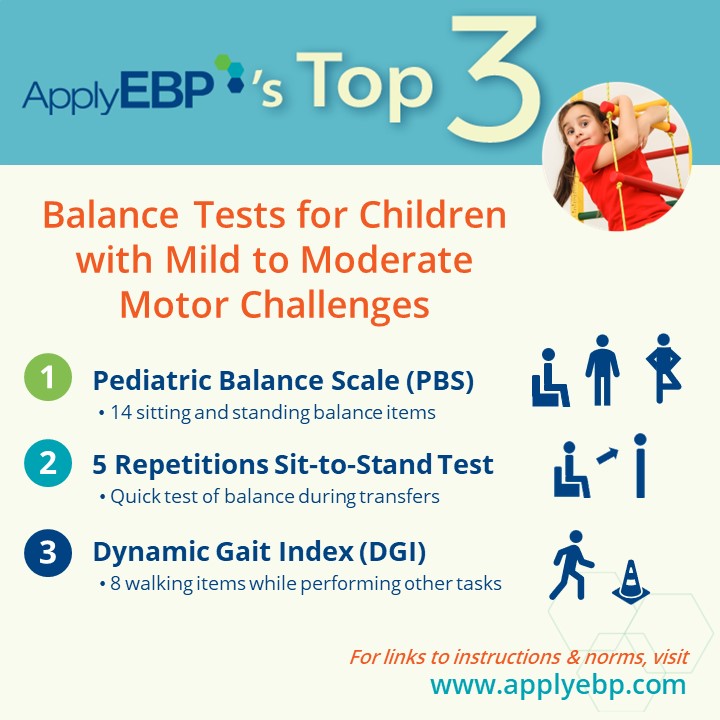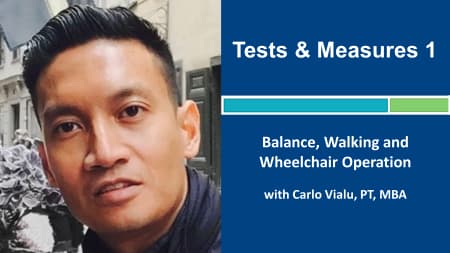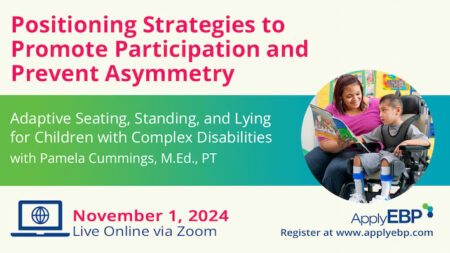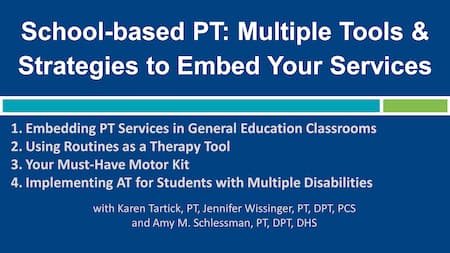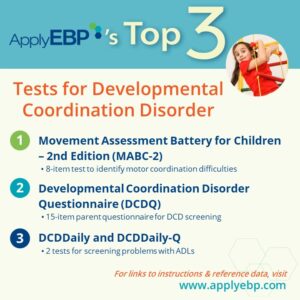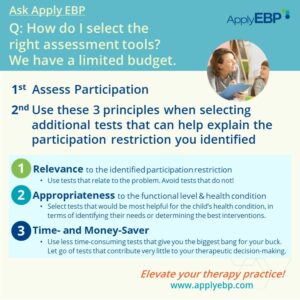Ask Apply EBP
Top 3 Balance Tests for Children with Mild to Moderate Motor Challenges
Note that this article is part of a series of articles on assessment. If you have not done so, first, read this articles:
-
-
-
- Must-Have Test and Organizing Your School-based Assessment – discusses the 5 critical reasons for assessing participation first
- 3 Principles for Selecting Tests – discusses the 3 principles to use when selecting tests at the activity and body function & structure levels
-
-
Q: What are best tests…for Balance in Children with Mild to Moderate Motor Challenges?
Here are our 3 favorite standardized tests for balance for children with mild to moderate motor challenges. If you are interested in tests for balance for children with moderate to complex motor challenges, watch out for our future posts here.
1. Pediatric Balance Scale (PBS)
A modification of the Berg Balance Scale, the PBS is composed of 14 different activities to test balance activities from simple (e.g., sitting to standing) to relatively more complex (e.g., retrieving object from floor).
-
-
- Test instruction: Click here for the PBS form and instructions
- Reference Data: Click here for reference data
- Equipment needed: timer, chair with armrests, bench, step stool about 6 inches high, tape, chalkboard eraser, yardstick
- Why we like this test:
- It includes static and dynamic items, including functional tasks that require balance such as transfers, retrieving object from floor, forward reach, and turning 360 degrees.
- It has the most robust reference data of all the tests included in this list.
- What to note: This test may have a low ceiling for children with mild motor challenges ages 7 years and older (i.e., it is easy for them to reach the highest scores). This decreases the usefulness of this tool as an outcome measure for this population.
-
2. Five Repetitions Sit-to-Stand Test
This tool measures the time to complete 5 consecutive cycles of sit-to-stand without the assistance of the subject’s arms.
-
-
- Test instruction: Click here for the procedures
- Reference Data: None at this time; the article above provides small group averages for children with typical development and children with CP, GMFCS Levels I, II and III
- Equipment needed:
- Why we like this test:
- It simulates a common action for transfers from sitting to standing.
- It is a quick test of balance.
- What to note: There is some mathematics involved in calculation repetitions per second. Calculate cautiously.
-
3. Dynamic Gait Index (DGI)
Includes 8 advanced items for measuring balance while walking, evaluating the ability to walk while performing different tasks and/or responding to different gait demands
-
-
- Test instruction: Click here for the DGI procedures
- Reference Data: Reference data (this needs access to paid article)
- Equipment needed: timer, floor tape, 2 cones, 1 shoebox
- Why we like this test:
- This is a “chewing gum while walking” type of test…in that it involves performing cognitive tasks, such as following verbal instructions while walking.
- This test has vestibular components, and include walking while avoiding obstacles
- It is the most advanced of the 3 tests in this list.
- What to note: The reference data is very small. It is best to use this as a criterion-referenced test.
-
For more on assessment and interventions for children with mild to moderate motor challenges, check out…
References:
Anderson, D. K., & Cech, D. (2019). Utilization of the Pediatric Modified Dynamic Gait Index: Issues Related to Child Development. Physical & Occupational Therapy In Pediatrics, 39(6), 669-678.
Franjoine, M. R., Gunther, J. S., & Taylor, M. J. (2003). Pediatric balance scale: a modified version of the berg balance scale for the school-age child with mild to moderate motor impairment. Pediatric physical therapy, 15(2), 114-128.
Franjoine, M. R., Darr, N., Held, S. L., Kott, K., & Young, B. L. (2010). The performance of children developing typically on the pediatric balance scale. Pediatric physical therapy, 22(4), 350-359.
Lubetzky-Vilnai, A., Jirikowic, T. L., & McCoy, S. W. (2011). Investigation of the Dynamic Gait Index in children: a pilot study. Pediatric physical therapy: the official publication of the Section on Pediatrics of the American Physical Therapy Association, 23(3), 268.
Wang, T. H., Liao, H. F., & Peng, Y. C. (2012). Reliability and validity of the five-repetition sit-to-stand test for children with cerebral palsy. Clinical rehabilitation, 26(7), 664-671.
Find More Answers to Your Questions in Our...
Featured School
Symposium
6th Online School-based OT and PT Symposium - On-demand Version
- Watch and re-watch on your own time
- On-Demand Version
- OTs, OTAs, PTs and PTAs
- $399-449
Featured Live
Workshop
Positioning Strategies to Promote Participation and Prevent Asymmetry
- November 1, 2024, 8:30 am - 3:30 pm Eastern Time
- Online via Zoom
- OTs, OTAs, PTs, PTAs & Educators
- $179-229
Featured On-Demand
Webinar
Tests & Measures 1: Balance, Walking
Featured Webinar
Bundle
School-based PT: Embedded Interventions Bundle
Have a question?
Submit here…
*Clicking submit will send your question directly to our email inbox. Your name and email will let us know that your submission is real (not spam). We will not include these in our posts, unless you tell us to include your name. Please read our privacy policy here.
All infographics and videos on www.applyebp.com are intellectual properties of Apply EBP, LLC
You may use the infographics and videos for free for any non-commercial, educational purposes. Please cite the source as “Apply EBP, LLC” and a link to the source article. If you plan to use any infographic or video for commercial purposes (i.e., for profit), please email Carlo@applyebp.com to obtain a written permission. Permission can be granted on a case-by-case basis.

